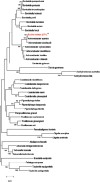Achromobacter buckle infection diagnosed by a 16S rDNA clone library analysis: a case report
- PMID: 25421607
- PMCID: PMC4255664
- DOI: 10.1186/1471-2415-14-142
Achromobacter buckle infection diagnosed by a 16S rDNA clone library analysis: a case report
Abstract
Background: In clinical settings, bacterial infections are usually diagnosed by isolation of colonies after laboratory cultivation followed by species identification with biochemical tests. However, biochemical tests result in misidentification due to similar phenotypes of closely related species. In such cases, 16S rDNA sequence analysis is useful. Herein, we report the first case of an Achromobacter-associated buckle infection that was diagnosed by 16S rDNA sequence analysis. This report highlights the significance of Achromobacter spp. in device-related ophthalmic infections.
Case presentation: A 56-year-old woman, who had received buckling surgery using a silicone solid tire for retinal detachment eighteen years prior to this study, presented purulent eye discharge and conjunctival hyperemia in her right eye. Buckle infection was suspected and the buckle material was removed. Isolates from cultures of preoperative discharge and from deposits on the operatively removed buckle material were initially identified as Alcaligenes and Corynebacterium species. However, sequence analysis of a 16S rDNA clone library using the DNA extracted from the deposits on the buckle material demonstrated that all of the 16S rDNA sequences most closely matched those of Achromobacter spp. We concluded that the initial misdiagnosis of this case as an Alcaligenes buckle infection was due to the unreliability of the biochemical test in discriminating Achromobacter and Alcaligenes species due to their close taxonomic positions and similar phenotypes. Corynebacterium species were found to be contaminants from the ocular surface.
Conclusions: Achromobacter spp. should be recognized as causative agents for device-related ophthalmic infections. Molecular species identification by 16S rDNA sequence analysis should be combined with conventional cultivation techniques to investigate the significance of Achromobacter spp. in ophthalmic infections.
Figures




Similar articles
-
Scleral buckle infection with Alcaligenes xylosoxidans.Indian J Ophthalmol. 2014 Jun;62(6):739-41. doi: 10.4103/0301-4738.136266. Indian J Ophthalmol. 2014. PMID: 25005211 Free PMC article.
-
Stenotrophomonas maltophilia and Mycobacterium chelonae coinfection of the extraocular scleral buckle explant.Ocul Immunol Inflamm. 2007 Nov-Dec;15(6):441-2. doi: 10.1080/09273940701732263. Ocul Immunol Inflamm. 2007. PMID: 18085488
-
Changing profile of organisms causing scleral buckle infections: a clinico-microbiological case series.Retina. 2014 Feb;34(2):247-53. doi: 10.1097/IAE.0b013e3182979e4a. Retina. 2014. PMID: 23807187
-
Diagnostic Approach to Ocular Infections Using Various Techniques From Conventional Culture to Next-Generation Sequencing Analysis.Cornea. 2017 Nov;36 Suppl 1:S46-S52. doi: 10.1097/ICO.0000000000001338. Cornea. 2017. PMID: 28902722 Review.
-
Mycoplasma hominis, a Rare but True Cause of Infective Endocarditis.J Clin Microbiol. 2015 Sep;53(9):3068-71. doi: 10.1128/JCM.00827-15. Epub 2015 Jul 1. J Clin Microbiol. 2015. PMID: 26135868 Free PMC article. Review.
Cited by
-
16S rRNA nanopore sequencing for the diagnosis of ocular infection: a feasibility study.BMJ Open Ophthalmol. 2022 May;7(1):e000910. doi: 10.1136/bmjophth-2021-000910. Epub 2022 May 24. BMJ Open Ophthalmol. 2022. PMID: 36161861 Free PMC article.
References
-
- Chouari R, Le Paslier D, Daegelen P, Dauga C, Weissenbach J, Sghir A. Molecular analyses of the microbial community composition of an anoxic basin of a municipal wastewater treatment plan reveal a novel lineage of proteobacteria. Microb Ecol. 2010;60:272–281. doi: 10.1007/s00248-009-9632-7. - DOI - PubMed
Pre-publication history
-
- The pre-publication history for this paper can be accessed here:http://www.biomedcentral.com/1471-2415/14/142/prepub
Publication types
MeSH terms
Substances
LinkOut - more resources
Full Text Sources
Other Literature Sources
Molecular Biology Databases
Miscellaneous

